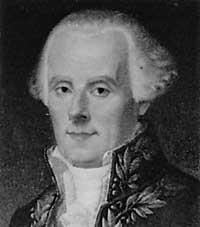Pierre Simon LAPLACE
French astronomer, mathematician and physicist was born in Beaumont in Auge in 1749. He was a humble family, but with the help of his neighbors he was able to go to school and train in mathematics. He immediately stood out and at 18 he moved to Paris.
d´Alembert requested the collaboration of the mathematician, but he refused. Laplace did not give in and sent an essay on mechanics to d´Alembert. This work, of great quality, was promoted by d´Alembert to obtain the chair of mathematics. In addition, the sponsor of Laplace achieved the appointment of professor of the Normal School and the Polytechnic School.

Laplace took his first steps in the field of physics, mainly in the study of specific heat. In 1780 he stated that the amount of heat needed for the decomposition of a substance together with Lavoisier is equal to the amount of heat produced by its components when generating it. In other words, they enunciated the fundamental basis of current thermochemistry and provided the first concepts of energy conservation.
Laplace then took over astronomy. He claimed that in 1787 the acceleration of the Moon was increasing and that this had much to do with the orbit of the Earth and the rest of the planets. He began to study the duration of the average movements of the planets, because he considered that it depended on that balance of the Solar System. Thus, he confirmed that the forces that generate the interaction between the orbits of the planets around the Sun have guaranteed the balance of the Solar System. All this theory was published in the five books Mécanique Céleste published between 1799 and 1825, collecting the contributions of Newton, d´Alembert or Halley.
In 1796 he published a book entitled Exposition du système du monde. In it he collected the theory of the system of Planets, published in several magazines. He claimed that the entire mechanism of the Universe could be expressed through mathematical functions and that all future events could be predicted thus.
Although he liked astromony, Laplace never abandoned mathematics and did many studies on probability calculation. The most outstanding were compiled in a large book entitled Théorie analytique des probabilités, published in 1795 and 1812. The book was printed twice when Laplace lived.
For many, Laplac's contributions are also due to his ability to adapt to the changes that occurred in France. He was an assistant to Napoleon and in 1806 gave him the title of Count. When Napoleon fell, he adapted perfectly to the new regime and Louis XVIII. the king named him marquis. Since 1785 he was a member of the Academy of Science and in 1817, a year after his approval at the French Academy, he was appointed director of that institution.
When he was about to turn 78, Count and Marquis Pierre Simon Laplace died in Paris.
Buletina
Bidali zure helbide elektronikoa eta jaso asteroko buletina zure sarrera-ontzian











